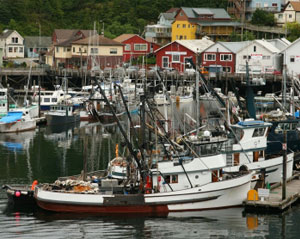Jobs in Ketchikan, Alaska and City Information
Ketchikan is a popular tourist and fishing town located on the Inside Passage of Southeast Alaska. The city’s unusual name comes from the word the native Tlingit people gave the city’s famous creek. Eventually both the creek and the city itself became known as Ketchikan.
You can also call the city the Salmon Capital of the World as its waters are rich with five different species of Pacific salmon, including the popular sockeye and king. Halibut also frequents the area’s waterway, which explains why Ketchikan attracts keen anglers from around the world. While you’re spending time on the water keep your eyes peeled for the area’s other native animals, which include harbor seals, bears, eagles, and porpoises.
Ketchikan is also known as the First City as it’s the first Alaskan port for many ferries and cruise ships. Travelers on these vessels invariably find themselves on Creek Street, which is actually a row of buildings perched on a boardwalk over the water. This historic strip, located just three or four blocks from the cruise ship docks, was once a red light district. Today there are many reminders of its bawdy past nestled amongst the museums and souvenir stores.
Venture a little further afield and you’re sure to spot totem poles. Ketchikan is actually home to more of these ancient American Indian sculptures than any other city. Look for them at Saxman Village, the Totem Heritage Center, and Totem Bight.
The wilderness surrounding Ketchikan is really beautiful, and a must for nature lovers to explore. The walking trails of the vast Tongass National Forest are ideal for hikers and campers who want to spend a little more time in the great outdoors. The sites are fairly primitive by modern standards, but without electricity and the contemporary gadgets it powers you can fully appreciate the majesty of your surrounds, and save cash at the same time.

A zip-line tour gives another unique perspective of the forest. Seaplanes also offer tourists a bird’s eye view of Ketchikan. They’re a great way to see the Misty Fjords and the local bears.
Just make sure that you pack your wellingtons and other wet weather gear. Ketchikan averages 165 inches of rainfall each year, which makes it the wettest town in the United States. The cheerful locals like to call it “liquid sunshine,” but you’ll enjoy your stay much more if you’ve got an umbrella with you! Wet weather gear is particularly important if you hope to spend time on the water or hiking the town’s forest trails, no matter what the season. Summertime showers are generally lighter than the relentless, wind-driven rain of Ketchikan’s winters, but these sporadic falls can still spoil your stay if you’re unprepared. Ketchikan enjoys a mild temperature, with average highs of 65°F during July and 39°F in January. The climate is certainly pleasant enough if you dress appropriately, but coats are vital in Ketchikan, particularly in the colder months.
Arriving to Ketchikan with an appetite is also a must. With its thriving fishing industry, fresh seafood is on the menu at most local restaurants. Fish lovers will adore the salmon and halibut that Ketchikan is famous for. It’s much fresher than the Alaskan king crab, which sounds local but is flown in frozen from Kodiak and Dutch Harbor. If you’ve got a taste for crustaceans try the homegrown Dungeness crab instead. As it’s much smaller it takes a bit of work, but the sweet meat is worth the trouble.
Ketchikan is accessible by cruise ships, Alaska’s ferries, and the air. Flights arrive at Ketchikan Airport from Seattle and Juneau several times each day. Taxis and buses service Ketchikan, helping travelers affordably get around the town and see the sights. However the locals believe there’s no better way to appreciate the area than slipping on some walking shoes and exploring on foot.

